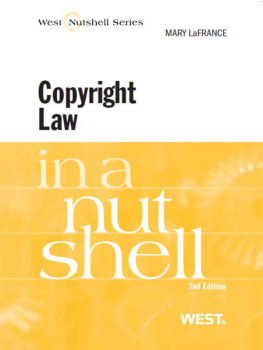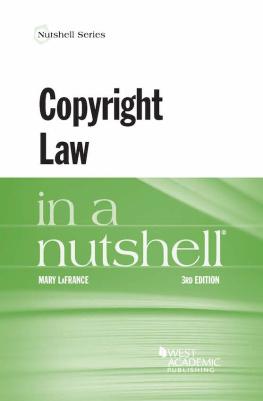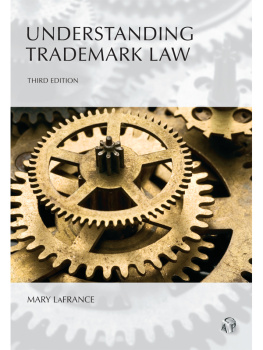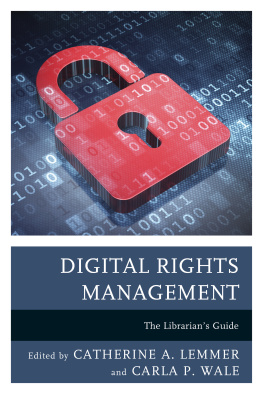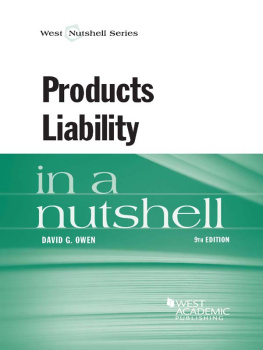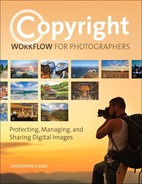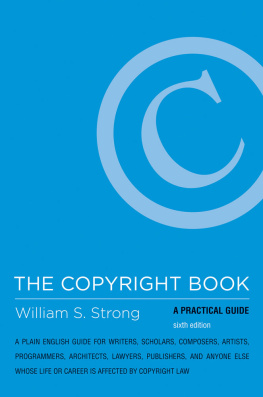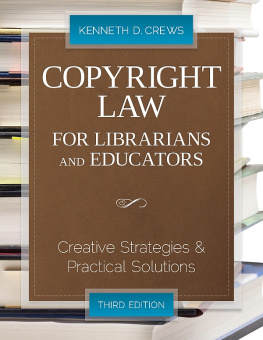Landmarks
Page list

WESTS LAW SCHOOL
ADVISORY BOARD
_________
JESSE H. CHOPER
Professor of Law and Dean Emeritus,
University of California, Berkeley
JOSHUA DRESSLER
Professor of Law, Michael E. Moritz College of Law,
The Ohio State University
YALE KAMISAR
Professor of Law, University of San Diego
Professor of Law Emeritus, University of Michigan
MARY KAY KANE
Professor of Law, Chancellor and Dean Emeritus,
University of California,
Hastings College of the Law
LARRY D. KRAMER
Dean and Professor of Law, Stanford Law School
JONATHAN R. MACEY
Professor of Law, Yale Law School
ARTHUR R. MILLER
University Professor, New York University
Formerly Bruce Bromley Professor of Law, Harvard University
GRANT S. NELSON
Professor of Law, Pepperdine University
Professor of Law Emeritus, University of California, Los Angeles
A. BENJAMIN SPENCER
Professor of Law,
Washington & Lee University School of Law
JAMES J. WHITE
Professor of Law, University of Michigan
I
COPYRIGHT LAW
IN A NUTSHELL
SECOND EDITION
By
MARY LaFRANCE
IGT Professor of
Intellectual Property Law
William S. Boyd School of Law
University of Nevada
Las Vegas

Mat #41092164
II
Thomson Reuters created this publication to provide you with accurate and authoritative information concerning the subject matter covered. However, this publication was not necessarily prepared by persons licensed to practice law in a particular jurisdiction. Thomson Reuters does not render legal or other professional advice, and this publication is not a substitute for the advice of an attorney. If you require legal or other expert advice, you should seek the services of a competent attorney or other professional.
Nutshell Series, In a Nutshell and the Nutshell Logo are trademarks registered in the U.S. Patent and Trademark Office.
West, a Thomson business, 2008
2011 Thomson Reuters
610 Opperman Drive
St. Paul, MN 55123
18003139378
Printed in the United States of America
ISBN: 9780314271907
III
To Gail
V
PREFACE
_________
This book is for anyone who needs a concise but thorough introduction to copyright law. It is aimed at lawyers, students, artists, authors, and businesspersons, as well as intelligent consumers who just want to know more about the copyright issues reported by the media.
Copyright law has grown increasingly complex over the years. Also, there are many misconceptions that are surprisingly persistent, and new misconceptions arising all the time. A better understanding of copyright law will prevent costly mistakes, avoid unnecessary litigation, encourage consumers to take an active interest in legislative proposals, and enable authors and artists to focus on their creative work without the distraction of legal entanglements.
The book assumes that the reader has no prior knowledge of copyright law, but it does not shy away from addressing aspects of the law which are ambiguous, in a state of flux, or the subject of conflicting opinions from courts and commentators. Where the law is still evolving, the text identifies the areas of uncertainty and the most recent authorities that have attempted a resolution. The text also notes areas where further legislation is needed or is currently under consideration.
VI
Because federal copyright law is a creature of statute, every aspect of copyright law addressed in the book is accompanied by references to the pertinent statutes and, where appropriate, their legislative histories. The most important aspects of each statute are discussed in the text, so that the reader can derive a good understanding of the material from the text alone. However, all of the relevant statutory citations are included in the text for those who wish to develop their understanding further.
VII
OUTLINE
_________
VIII
IX
X
XI
XII
XIII
XIV
XV
XVI
XVII
XXIX
COPYRIGHT LAW
IN A NUTSHELL
SECOND EDITION
CHAPTER 1
INTRODUCTION
The Patent and Copyright Clause of the United States Constitution grants Congress the power to Promote the Progress of Science and useful Arts, by securing for limited Times to Authors and Inventors the exclusive right to their respective Writings and Discoveries. U.S. CONST., art. 1, sec. 8, cl. 8. The first federal copyright statute was enacted in 1790. Since then, the legislative scheme has been revised many times.
The most recent comprehensive revision of the federal copyright laws culminated in the Copyright Act of 1976 (the 1976 Act), which took effect on January 1, 1978, and which is codified, with amendments, in Title 17 of the United States Code. Perhaps the most significant change introduced by the 1976 Act was the elimination of common law copyright protection for fixed works of authorship. Under the Copyright Act of 1909 (the 1909 Act) and earlier federal statutes, unpublished works of authorship enjoyed perpetual common law copyright protection, a doctrine carried over from English law. For most works, federal copyright law did not apply until publication. In contrast, under the 1976 Act, federal copyright attached to an original work of authorship from the moment it was fixed in a tangible medium of expression. Thus, as of January 1, 1978, common law copyright was virtually eliminated. Moreover, any attempt by a state to provide its own equivalent of copyright protection to fixed works, published or not, was expressly preempted by federal law. Thereafter, only unfixed works could be protected by state copyright law.
Essential to federal (as opposed to common law) copyright is the concept of the limited term, which is required by the limited Times language of the Patent and Copyright Clause. Any work published in the United States before 1923 has now entered the public domain due to expiration of its term of protection. However, many works published as early as 1923 are still protected by copyright. Indeed, the last works published under the 1909 Act will not enter the public domain until 2072.
Because copyright in works created or published prior to January 1, 1978, is governed in many respects by the 1909 Copyright Act, a copyright lawyer must be familiar with both the 1976 Act and the 1909 Act in order to accurately assess the current copyright status and ownership of these pre1978 works. For that reason, although this text focuses on the 1976 Act, it also addresses those provisions of the 1909 Act that are essential to modern copyright practice. Except where otherwise indicated, all statutory references in this text refer to Title 17.
CHAPTER 2
COPYRIGHTABLE SUBJECT MATTER
2.1 Original Works of Authorship
Subject to limited exceptions in 104 (foreign works) and 105 (United States government works), the fundamental rules regarding copyrightable subject matter are established by 102.
Under current law, compliance with formalities is not a prerequisite to copyright protection. Thus, a work that satisfies 102 is protected by federal copyright from the moment it is fixed in a tangible medium of expression, without regard to whether it bears a copyright notice or has been registered. However, as discussed in Chapter 9, in order to enforce his or her exclusive rights through an infringement proceeding, the copyright owner is typically required to register the copyright, and as discussed in Chapter 4, copyright notice and registration offer additional benefits.

